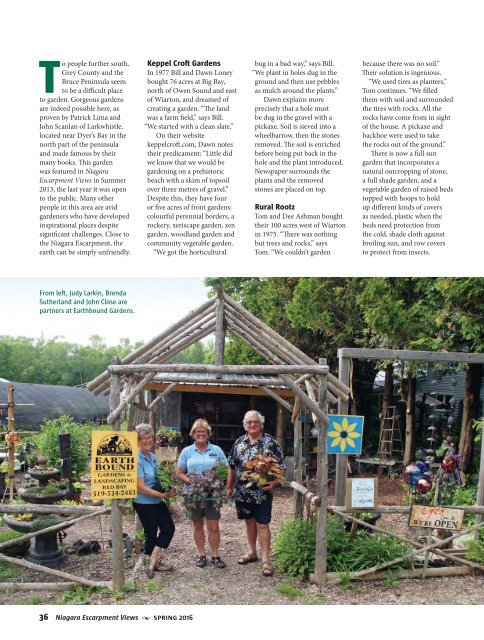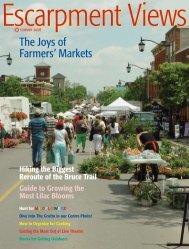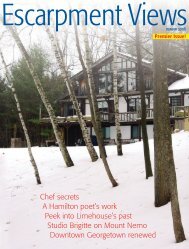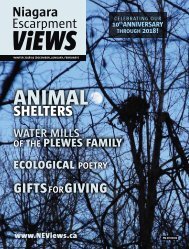Niagara Escarpment Views - Spring 2016
Create successful ePaper yourself
Turn your PDF publications into a flip-book with our unique Google optimized e-Paper software.
To people further south,<br />
Grey County and the<br />
Bruce Peninsula seem<br />
to be a difficult place<br />
to garden. Gorgeous gardens<br />
are indeed possible here, as<br />
proven by Patrick Lima and<br />
John Scanlan of Larkwhistle,<br />
located near Dyer’s Bay in the<br />
north part of the peninsula<br />
and made famous by their<br />
many books. This garden<br />
was featured in <strong>Niagara</strong><br />
<strong>Escarpment</strong> <strong>Views</strong> in Summer<br />
2013, the last year it was open<br />
to the public. Many other<br />
people in this area are avid<br />
gardeners who have developed<br />
inspirational places despite<br />
significant challenges. Close to<br />
the <strong>Niagara</strong> <strong>Escarpment</strong>, the<br />
earth can be simply unfriendly.<br />
Keppel Croft Gardens<br />
In 1977 Bill and Dawn Loney<br />
bought 76 acres at Big Bay,<br />
north of Owen Sound and east<br />
of Wiarton, and dreamed of<br />
creating a garden. “The land<br />
was a farm field,” says Bill.<br />
“We started with a clean slate.”<br />
On their website<br />
keppelcroft.com, Dawn notes<br />
their predicament: “Little did<br />
we know that we would be<br />
gardening on a prehistoric<br />
beach with a skim of topsoil<br />
over three metres of gravel.”<br />
Despite this, they have four<br />
or five acres of front gardens:<br />
colourful perennial borders, a<br />
rockery, xeriscape garden, zen<br />
garden, woodland garden and<br />
community vegetable garden.<br />
“We got the horticultural<br />
bug in a bad way,” says Bill.<br />
“We plant in holes dug in the<br />
ground and then use pebbles<br />
as mulch around the plants.”<br />
Dawn explains more<br />
precisely that a hole must<br />
be dug in the gravel with a<br />
pickaxe. Soil is sieved into a<br />
wheelbarrow, then the stones<br />
removed. The soil is enriched<br />
before being put back in the<br />
hole and the plant introduced.<br />
Newspaper surrounds the<br />
plants and the removed<br />
stones are placed on top.<br />
Rural Rootz<br />
Tom and Dee Ashman bought<br />
their 100 acres west of Wiarton<br />
in 1975. “There was nothing<br />
but trees and rocks,” says<br />
Tom. “We couldn’t garden<br />
because there was no soil.”<br />
Their solution is ingenious.<br />
“We used tires as planters,”<br />
Tom continues. “We filled<br />
them with soil and surrounded<br />
the tires with rocks. All the<br />
rocks have come from in sight<br />
of the house. A pickaxe and<br />
backhoe were used to take<br />
the rocks out of the ground.”<br />
There is now a full sun<br />
garden that incorporates a<br />
natural outcropping of stone,<br />
a full shade garden, and a<br />
vegetable garden of raised beds<br />
topped with hoops to hold<br />
up different kinds of covers<br />
as needed, plastic when the<br />
beds need protection from<br />
the cold, shade cloth against<br />
broiling sun, and row covers<br />
to protect from insects.<br />
From left, Judy Larkin, Brenda<br />
Sutherland and John Close are<br />
partners at Earthbound Gardens.<br />
36 <strong>Niagara</strong> <strong>Escarpment</strong> <strong>Views</strong> • spring <strong>2016</strong>

















